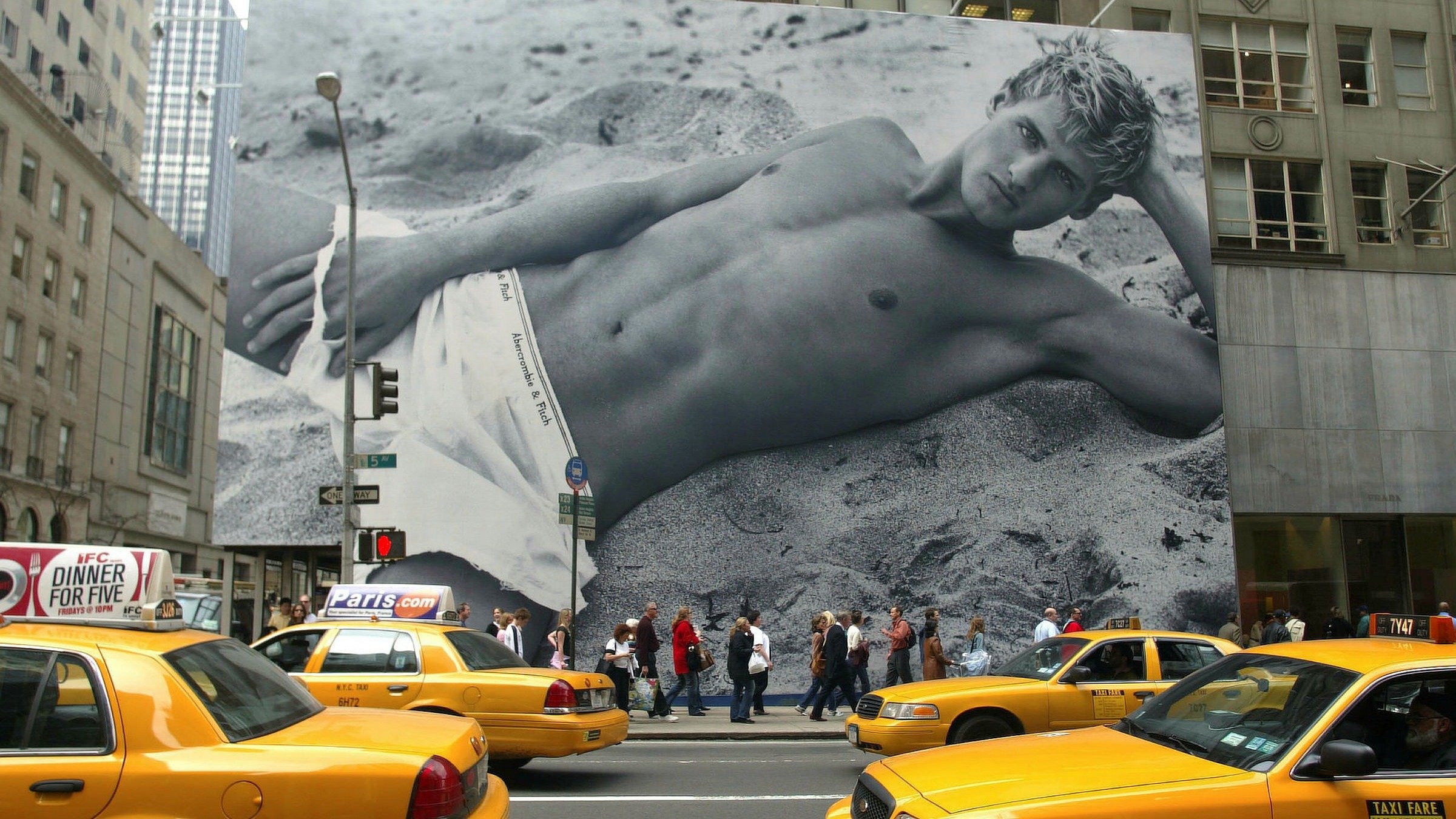Revenge of the Uncool Kids
Schadenfreude is one of my favorite words. Derived from the German, Merriam-Webster defines it as “enjoyment obtained from the troubles of others,” which admittedly, sounds awful. Except when said others really have it coming.
I recently fired up the Netflix machine to watch a documentary called White Hot: The Rise and Fall of Abercrombie & Fitch. For those who are unfamiliar with 90’s mall culture, Abercrombie & Fitch was a popular chain that popped up in malls across America at about the same time your humble columnist was peeking out of the closet. The stores were dark and reeked of their signature cologne, and the front doors were often flanked by shirtless college boys, paid to look gorgeous and bored.
A 90s-era A&F ad in New York City.
I never had the nerve to actually visit an A&F store more than once or twice as a young man. I instinctively knew that I was not part of their “lacrosse bro” target market, and that wearing any of their clothing (which was wholly unremarkable, but usually featured a huge logo, turning its wearer into a walking advertisement) would only highlight the distance between myself and the bronzed, six-packed, nearly naked models that peopled all their advertising. Those ads were the reason why, although I was never a customer, Abercrombie & Fitch were ubiquitous in my young gay life. Consisting almost solely of well-built, collegiate white boys photographed mid-frolic in black-and-white by photographer Bruce Weber, I couldn’t take my eyes off them. On the one hand, the ads – easily the most homoerotic images I’ve ever seen outside of pure pornography – were fertile soil for my young gay imagination. On the other, the exquisite rush of seeing those beautiful naked men (one of the interview subjects in White Hot called attention to the irony of selling clothes with a marketing campaign featuring hardly any garments at all) was nearly always followed by a familiar sense of dejection.
At the time, I never faulted Abercrombie & Fitch for this. Like all of us with less-than-perfect bodies in an appearance-obsessed culture, the blame was usually aimed inward. It never occurred to me that the Chief Executive Officer of a clothing store chain was trying to make me feel hideous on purpose. After all, I didn’t know his name and he certainly didn’t know mine. And yet, that’s exactly what was happening. Not only to me, of course, but yes, making most of America feel awful was exactly the counter-intuitive strategy that made Abercrombie & Fitch a towering success – for a time.
In a 2006 profile of A&F CEO Mike Jeffries in Salon magazine, he’s quoted as saying, “In every school there are the cool and popular kids, and then there are the not-so-cool kids. Candidly, we go after the cool kids.” And he said a lot more, but it basically boiled down to the idea that one way to excite your target customer is to alienate everyone else. In other words, exclusion sells.
Former Abercrombie & Fitch CEO Mike Jeffries
And it did, for more than a decade. But all bad things must come to an end. First there was a 2004 class action suit brought by several people of color who were discriminated against or denied employment altogether because of their race (many of the plaintiffs are featured in White Hot). This suit ended with a settlement and an accompanying consent decree, but no admission of guilt. Later, they were sued by Samantha Elauf, born and raised in Tulsa, Oklahoma, who was denied employment because of a headscarf (Elauf is Muslim). This time, A&F doubled down and allowed the case to be taken all the way to the Supreme Court, who ruled in Elauf’s favor 8-1.
The documentary also explores other interesting questions, such as whether a company with the exclusionary ethos of A&F could survive in the age of social media, or if legal remedies like consent decrees can really change a corporate culture with no interest in transforming.
Long story short (and you should definitely watch the documentary for more), Jeffries resigned in 2014. While he was given a payout worth tens of millions, he will primarily be remembered for his failed leadership, illegal business practices, and (it must be said) horrendously bad plastic surgery, proof that the eternal youth he was selling is, in fact, not real. Long story short, Mike Jeffries’ legacy isn’t about youth, or sex appeal, or money. It’s about racism, and cruelty. That’s what people will remember. And after all he did to make so many people feel terrible about themselves, that isn’t just enjoyable – it’s schadenfreudelicious.



